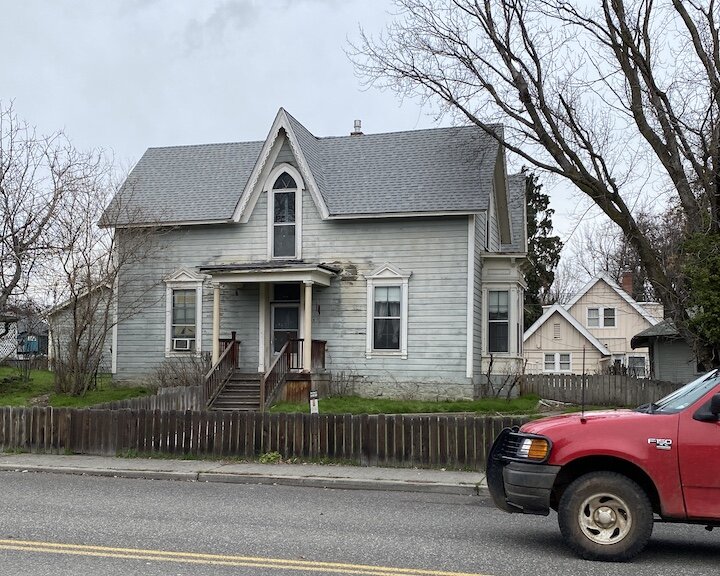TD Home Prices Shoot Up as Housing Stock Dries Up
Housing Shortage - Homes such as this 2,100 square-foot 130-year-old American Gothic at 415 Third Street in The Dalles are few and far between when it comes to sales. The house needs to be refurbished and was listed at $229,000. It recently went pending. It was one of nine homes priced under $350,000 in The Dalles this January. In total, there were just 24 houses on the market as of last Friday, an all-time low, according to realtors.
By Tom Peterson
The housing market is on fire nationally. And The Dalles is helping to stoke the flames.
House prices in the US were up 9% in 2020 from the year before, with the annual median price of an existing home climbing to $296,500 according to a report from the National Association of Realtors.
That is the highest price on record.
Dennis Morgan
The Dalles can do that report one better.
There were just 24 homes for sale in all of The Dalles last week, according to Copper West Broker Dennis Morgan.
“Average prices, year to date, are at $308,000,” beating the national median, Morgan said. And the average sale price for December was $353,000. That’s an 11.7 % increase year over year. That’s been pretty consistent for the past three years.”
Morgan said he had sold two houses in the past month which needed to be entirely refurbished because there is not much else to choose from in the under $250,000 range.
Columbia River Properties’ Jim Wilcox has been tracking the trends for decades.
He said 296 Houses in the 97058 zip code sold in 2020. That is just 17 off the record 313 in 2018, according to his statistics.
So, what’s going on?
It appears outside pressures from buyers coming from metropolitan areas are buying housing stock at higher prices, while contractors coming to the community for work continue to create strong demand in the rental market.
“I’ve been in the business for 32 years, and listings have never been this low,” Wilcox said last Friday. “There is no selection, and we’re not building fast enough.”
Jim Wilcox
The upshot?
Developers and contractors that have locked down land are in primetime with a lot of buyers and little stock until demand catches up, which does not appear likely without the advancement of major subdivision developments.
Look to Lone Pine Village and Park Place subdivisions currently underway. Lone Pine, near The Dalles Bridge now has 25 homes filled in its first phase, and additional homes are now going up in its prime riverfront locations.
Park Place near Sorosis Park broke ground in May 2019. It now has 14 of 33 homes either constructed or in final stages, and the internal street has been opened up to allow for additional building.
The Dalles is essentially landlocked within its urban growth boundary when it comes to expanding developable land - there is none. So the city has turned to infill, additional dwelling units and multiple housing units such as duplexes.
Rough for Entry-Level Buyers
First-time homebuyers are being priced out of the market, where the cost of housing challenges their ability to get financing based on their income.
Wilcox said 15 of 24 homes listed were priced at more than $350,000, so essentially little to no selection for young couples struggling to come up with a downpayment.
Younger buyers from Hood River were often turning to The Dalles in years past as home prices were about 20 percent less expensive here. But that trend is now ceasing to exist, and those buyers pushed either east to Rufus, for example, or South To Maupin to find affordable housing.
It’s tricky, to say the least; Not Enough Boots On The Ground
When the market is “healthy” there are about 150 houses for sale, said Wilcox. So it is clear that there is a big supply shortage in housing currently in The Dalles.
Wilcox said, Oregon as a whole, has lagged for years in keeping up with housing demand. He said the state needs to build 30,000 units of housing every year for the next 20 years to catch up. Right now, that number stands around 17,000, he said.
“There’s no inventory anywhere,” added Morgan. “There’s none in Portland, there’s zero in Pendleton.”
“If we do not get any more listings (in The Dalles), we will sell out within a month,” Morgan said.
Rural Wasco County: Second Verse, Same as the First
Ellie Webb
“There is no supply; It is really tight,” said Ellie Webb, Broker with Columbia River Properties. She sells farm and ranch properties south and east in Wasco County.
“Were seeing people from Portland, Vancouver, Seattle and a fair share from California.”
“Everyone wants high-speed internet access,” she said, noting many are moving away from the city and need to telecommute. “We’re seeing people that are wanting a full-time residence.”
“I just sold a 20 acre farm in the Dufur Valley and I have another 40 acres pending,” she said.
Webb was unsure how long the hot market could continue.
“I feel like the stock market and the housing market can’t stay great forever. There has to be a correction. I am worried about when the eviction extensions run out. When all that has to be paid again, there could be a real correction.”
“On the flip side, a lot of transactions are cash - they are fine- I am worried about people buying at low interest rates, but when the rate goes up to, say, 4 percent they can’t afford as much house and so the buyer pool shrinks.
Tammi Austin
Annual percentage rates for a 30-year fixed loan stood at 2.75 percent last Friday, said Tammi Austin Platinum Mortgage Branch Manager. A 15-year fixed was 2.375 percent.
While housing availability is at an all-time low, realtors speculate the market will hinge both on the boom in telecommuters and others looking to get out of metropolitan areas such as Vancouver and Portland. At the same time, Google and other industries continue to draw much contract work and the need for short-term rentals. Indicators just keep pointing toward a housing shortage - a sellers market, with higher prices and less housing stock.





